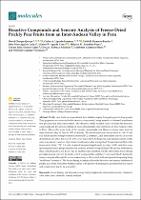| dc.contributor.author | Choque Quispe, David | es_PE |
| dc.contributor.author | Ligarda Samanez, Carlos Alberto | es_PE |
| dc.contributor.author | Huamán Rosales, Edith R. | es_PE |
| dc.contributor.author | Aguirre Landa, John Peter | es_PE |
| dc.contributor.author | Agreda Cerna, Henrry Wilfredo | es_PE |
| dc.contributor.author | Zamalloa Puma, Miluzka M. | es_PE |
| dc.contributor.author | Álvarez López, Genaro Julio | es_PE |
| dc.contributor.author | Barboza Palomino, Gloria I. | es_PE |
| dc.contributor.author | Alzamora Flores, Humberto | es_PE |
| dc.contributor.author | Gamarra Villanueva, Wilfredo | es_PE |
| dc.date.accessioned | 2024-01-08T14:21:37Z | |
| dc.date.available | 2024-01-08T14:21:37Z | |
| dc.date.issued | 2023 | |
| dc.identifier.uri | https://hdl.handle.net/20.500.14168/810 | |
| dc.description.abstract | Prickly pear fruits are seasonal and have shades ranging from pale green to deep purple.
Their pigments are associated with bioactive compounds, being sensitive to thermal transformation
processes for their conservation. The objective of this research was to evaluate the bioactive
compounds and the sensory analysis of freeze-dried prickly pear fruits from an inter-Andean valley
in Peru. The prickly pear fruits of the morada, anaranjada, and blanca ecotypes came from an
inter-Andean valley in Peru at 2972 m altitude. The sliced fruits were freeze-dried at 40 C and
0.25 mTorr, and the total polyphenol content (TPC), vitamin C, and antioxidant activity (AA) were
determined, as well as the color L* a* b*, color index (CI*), FTIR spectra, and mineral content. In the
same way, sensory analysis of preferences with nine scales was applied. It was observed that in the
freeze-dried fruits, TPC, AA, and vitamin C increased significantly (p-value < 0.05), and their corresponding
functional groups increased in intensity in their corresponding FTIR spectra; furthermore,
trace elements such as Cu, Fe, Se, Zn, Si, and Mn were identified. On the other hand, freeze-drying
provided deeper colors to the fruits, which most panelists said they “very much liked” during the
sensory analysis, although the texture was not very well accepted, with most panelists reporting being
“indifferent” towards it. The freeze-drying technique allows the bioactive and sensory attributes of
prickly pear fruits from inter-Andean valleys to be preserved, making it a potential fruit for export
and conservation due to its seasonality. | es_PE |
| dc.format | application/pdf | es_PE |
| dc.language.iso | eng | es_PE |
| dc.publisher | Revistas MDPI | es_PE |
| dc.rights | info:eu-repo/semantics/openAccess | es_PE |
| dc.rights | Attribution-NonCommercial-NoDerivatives 4.0 Internacional | * |
| dc.rights.uri | info:eu-repo/semantics/openAccess | es_PE |
| dc.rights.uri | http://creativecommons.org/licenses/by-nc-nd/4.0/ | * |
| dc.subject | freeze-drying; prickly pear ecotype; total polyphenols; antioxidant activity; vitamin C; color index; trace elements; sensory analysis | es_PE |
| dc.title | Bioactive compounds and sensory analysis of freeze-dried prickly pear fruits from an inter andean valley in Peru | es_PE |
| dc.type | info:eu-repo/semantics/article | es_PE |
| dc.type.version | info:eu-repo/semantics/publishedVersion | es_PE |
| dc.publisher.country | CH | es_PE |
| dc.subject.ocde | http://purl.org/pe-repo/ocde/ford#2.11.04 | es_PE |
| dc.identifier.doi | https:// doi.org/10.3390/molecules28093862 | es_PE |


